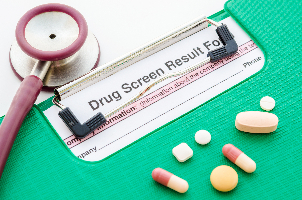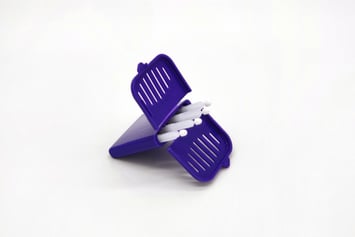Share this
anti-doping in drug screening: how it works
by Neoteryx Microsampling on Jul 26, 2021 9:00:00 AM
 Doping in sport has been a major challenge worldwide, threatening the integrity of sports competitions, as well as athletes’ health, and even their lives. The use of performance enhancing drugs (PEDs) in competitive sports has been banned for many years, but the problem persists. Doping in athletics dates back to the 1920s and has become more sophisticated over the years despite efforts to curb it.
Doping in sport has been a major challenge worldwide, threatening the integrity of sports competitions, as well as athletes’ health, and even their lives. The use of performance enhancing drugs (PEDs) in competitive sports has been banned for many years, but the problem persists. Doping in athletics dates back to the 1920s and has become more sophisticated over the years despite efforts to curb it.
Issues around doping in sport increased in the 1990s, leading to the establishment of the World Anti-Doping Agency (WADA) in 1999 to fight against doping in sports worldwide using the World Anti-Doping Code. Most anti-doping organizations base their anti-doping programs on this document to coordinate anti-doping policies, rules, and regulations.
With the 2021 Tokyo Olympics and other sporting events moving forward, anti-doping organizations have been screening athletes for banned substances as part of the qualification process. They typically use urine and blood samples for the screenings. According to WADA, 24,430 samples had been collected by 152 anti-doping organizations as of May 2021.
This is the highest number of samples collected since the global pandemic began in March 2020. Sadly, many athletes were disqualified from participating in the Olympics after testing positive for prohibited drugs, according to the Anti-Doping Rule Violations (ADRV).
How Athletes Are Screened for Drug Use
The drug testing procedure is broadly divided into seven stages:
1. Selection of Athletes
WADA requires athletes to be tested in and out of competition. It also stipulates the prohibited substances tested in both situations. In-competition athletes are tested for:
- Narcotics
- Stimulants
- Glucocorticosteroids
- Cannabinoids
Specimen collection and testing are performed 12 hours before a national or international sporting event. Out-of-competition athletes are tested for:
- Anabolic agents
- Beta-2 agonists
- Diuretics and other masking agents
- Peptide hormones
2. Athlete Notification for Testing
An assigned Doping Control Officer (DCO) usually locates the athletes and informs them about the requirement to provide a sample and their rights and responsibilities. Athletes are also required to sign a form to acknowledge and accept the notification.
3. Sample Selection
Blood and urine samples are used for drug testing in athletes. For urine sample collection, the DCO ensures an unobstructed view of the sample leaving the athlete’s body. A 90 ml sample is collected in a tamper-proof bottle.
For blood testing, athletes follow similar procedures, but a healthcare professional typically collects the sample under the supervision of the DCO. Despite the development of less-invasive blood collection methods using finger-stick methods or others, most sport testing agencies and officers currently use phlebotomy practices to collect liquid blood samples via venipuncture (a needle in the vein of the arm). The wet blood is collected in vials, stored, and transported for analysis at 2-12° C.
4. Declaration and Certification
The athletes must inform the DCO about medications or supplements they have taken in the last seven days.
5. Transfer of the Samples to the Lab
Once the samples and accompanying documents are presented to the Doping Control Station, each custody transfer is documented until the samples arrive at the laboratory. The samples may be processed in toxicology or clinical laboratories.
6. Lab Testing
Urine analysis:
Urine samples are subjected to lab analysis using a range of tests. Each analytical test is appropriate to the respective prohibited substance, whether testing in-competition or out-of-competition.
For example, liquid chromatography and gas chromatography separates the drugs and the metabolites in the sample. The two tests are used along with mass spectrometry to determine the structure of the drugs.
Blood analysis:
- Detects any blood manipulation through transfusion
- Identifies biomarkers for the human growth hormone
- Quantifies endogenous blood parameters like reticulocytes, hemoglobin, and hematocrit
Routine monitoring of such blood parameters also detects indirect doping practices. The parameters are recorded on the Athlete’s Biological Passport (ABP).
7. Reporting the Results
The lab analysis results are reported to the respective anti-doping organization. If the analysis didn’t detect any prohibited substances, the athlete can participate in the competition.
If test results are positive for any prohibited substance, the athletes are in violation of ADRV, and the anti-doping organization must notify them. The athletes may request another analysis of sample B to be conducted in their presence accompanied by their representative. WADA may disqualify the athletes or set a period of ineligibility to compete depending on the ADRV.
Changes in Blood Sample Collection Methods
Due to several disadvantages presented by traditional venipuncture blood draws, including high costs, complicated transport and storage, and discomfort for athletes, WADA is allowing anti-doping organizations to use alternative blood collection methods.
One such method is the dried blood spot (DBS) or dried blood microsampling method. WADA issued a statement in May 2021 stating its approval for use of dried blood microsampling at the 2021 Tokyo Olympics.
The organization believes this blood sample collection method offers advantages, such as:
- Less expensive sample collection
- Easier sample collection; requires only a simple finger-prick for a small volume of blood
- Less invasive than venipuncture; a better experience for the athletes
- Less space needed for dried sample storage
- Greater sample stability, when dried
Different finger-prick devices will be used to collect samples during the Olympics on a trial basis to identify the best one for blood sample collection, transport and testing.
/hemaPEN%20images%20(approved)/lightbox-hemapen-solo-3-xtr-brit-1-1-1.jpeg?width=353&height=206&name=lightbox-hemapen-solo-3-xtr-brit-1-1-1.jpeg) It was an excellent opportunity to try blood sampling devices like the hemaPEN® or the Mitra device® that uses VAMS® technology, based on absorptive microsampling.
It was an excellent opportunity to try blood sampling devices like the hemaPEN® or the Mitra device® that uses VAMS® technology, based on absorptive microsampling.
These devices facilitate remote microsampling using the finger-prick method. A lancet is used to prick the fingertip, and either the tip of the hemaPEN or the VAMS tips on the Mitra device wicks up a few drops of capillary blood.
 The devices are then sealed in their protective plastic housings and sent to the designated lab for analysis.
The devices are then sealed in their protective plastic housings and sent to the designated lab for analysis.
The hemaPEN has the added advantage of locking when it is closed into its plastic base, which discourages sample tampering after initial sample collection. The hemaPEN cannot be re-opened after it has been "clicked" shut and remains locked until it reaches the laboratory.
Both hemaPEN and Mitra devices have proved to deliver high-quality samples to test many compounds, with results that correlate well with results from traditional wet blood samples.
The Future of Blood Sample Collection Analysis
WADA has approved specific laboratories around the world to perform tests for the Olympics and international sports events. For the Olympic competitions in Japan, the samples were analyzed at a WADA-accredited lab in Tokyo.
The recent transition to finger-prick blood sampling methods has created the need to set up more WADA labs that are qualified to analyze dried blood samples. We look forward to a future of minimally invasive anti-doping drug screening programs that utilize blood microsampling.
Image Credits: Trajan, Neoteryx, Shutterstock
Share this
- Microsampling (206)
- Research, Remote Research (119)
- Venipuncture Alternative (105)
- Clinical Trials, Clinical Research (83)
- Mitra® Device (73)
- Therapeutic Drug Monitoring, TDM (51)
- Dried Blood Spot, DBS (39)
- Biomonitoring, Health, Wellness (30)
- Infectious Disease, Vaccines, COVID-19 (24)
- Blood Microsampling, Serology (23)
- Omics, Multi-Omics (21)
- Decentralized Clinical Trial (DCT) (20)
- Specimen Collection (18)
- Toxicology, Doping, Drug/Alcohol Monitoring, PEth (17)
- Skin Microsampling, Microbiopsy (14)
- hemaPEN® Device (13)
- Preclinical Research, Animal Studies (12)
- Pharmaceuticals, Drug Development (9)
- Harpera Device (7)
- Industry News, Microsampling News (5)
- Antibodies, MAbs (3)
- Company Press Release, Product Press Release (3)
- Environmental Toxins, Exposures (1)
- July 2025 (1)
- May 2025 (1)
- April 2025 (2)
- December 2024 (2)
- November 2024 (1)
- October 2024 (3)
- September 2024 (1)
- June 2024 (1)
- May 2024 (1)
- April 2024 (4)
- March 2024 (1)
- February 2024 (2)
- January 2024 (4)
- December 2023 (3)
- November 2023 (3)
- October 2023 (3)
- September 2023 (3)
- July 2023 (3)
- June 2023 (2)
- April 2023 (2)
- March 2023 (2)
- February 2023 (2)
- January 2023 (3)
- December 2022 (2)
- November 2022 (3)
- October 2022 (4)
- September 2022 (3)
- August 2022 (5)
- July 2022 (2)
- June 2022 (2)
- May 2022 (4)
- April 2022 (3)
- March 2022 (3)
- February 2022 (4)
- January 2022 (5)
- December 2021 (3)
- November 2021 (5)
- October 2021 (3)
- September 2021 (3)
- August 2021 (4)
- July 2021 (4)
- June 2021 (4)
- May 2021 (4)
- April 2021 (3)
- March 2021 (5)
- February 2021 (4)
- January 2021 (4)
- December 2020 (3)
- November 2020 (5)
- October 2020 (4)
- September 2020 (3)
- August 2020 (3)
- July 2020 (6)
- June 2020 (4)
- May 2020 (4)
- April 2020 (3)
- March 2020 (6)
- February 2020 (3)
- January 2020 (4)
- December 2019 (5)
- November 2019 (4)
- October 2019 (2)
- September 2019 (4)
- August 2019 (4)
- July 2019 (3)
- June 2019 (7)
- May 2019 (6)
- April 2019 (5)
- March 2019 (6)
- February 2019 (5)
- January 2019 (8)
- December 2018 (3)
- November 2018 (4)
- October 2018 (7)
- September 2018 (6)
- August 2018 (5)
- July 2018 (8)
- June 2018 (6)
- May 2018 (5)
- April 2018 (6)
- March 2018 (4)
- February 2018 (6)
- January 2018 (4)
- December 2017 (2)
- November 2017 (3)
- October 2017 (2)
- September 2017 (4)
- August 2017 (2)
- July 2017 (4)
- June 2017 (5)
- May 2017 (6)
- April 2017 (6)
- March 2017 (5)
- February 2017 (4)
- January 2017 (1)
- July 2016 (3)
- May 2016 (1)
- April 2016 (2)



No Comments Yet
Let us know what you think